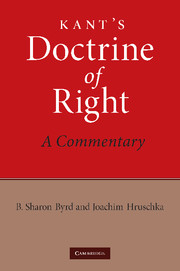Book contents
- Frontmatter
- Contents
- Introduction and methods of interpretation
- Chapter 1 The idea of the juridical state and the postulate of public law
- Chapter 2 The state of nature and the three leges
- Appendix to Chapter 2 Iustitia tutatrix, iustitia commutativa, and iustitia distributiva and their differences
- Chapter 3 The right to freedom
- Chapter 4 The permissive law in the Doctrine of Right
- Chapter 5 The external mine and thine
- Chapter 6 Intelligible possession of land
- Chapter 7 The “state in the idea”
- Chapter 8 The state in reality
- Chapter 9 International and cosmopolitan law
- Chapter 10 The “idea of public law” and its limits
- Chapter 11 Contract law I. Why must I keep my promise?
- Chapter 12 Contract law II. Kant's table of contracts
- Chapter 13 Criminal punishment
- Chapter 14 The human being as a person
- Appendix I to Chapter 14 On the logic of “‘ought’ implies ‘can’”
- Appendix II to Chapter 14 The system of rules of imputation
- Bibliography
- Index
Chapter 9 - International and cosmopolitan law
Published online by Cambridge University Press: 05 June 2012
- Frontmatter
- Contents
- Introduction and methods of interpretation
- Chapter 1 The idea of the juridical state and the postulate of public law
- Chapter 2 The state of nature and the three leges
- Appendix to Chapter 2 Iustitia tutatrix, iustitia commutativa, and iustitia distributiva and their differences
- Chapter 3 The right to freedom
- Chapter 4 The permissive law in the Doctrine of Right
- Chapter 5 The external mine and thine
- Chapter 6 Intelligible possession of land
- Chapter 7 The “state in the idea”
- Chapter 8 The state in reality
- Chapter 9 International and cosmopolitan law
- Chapter 10 The “idea of public law” and its limits
- Chapter 11 Contract law I. Why must I keep my promise?
- Chapter 12 Contract law II. Kant's table of contracts
- Chapter 13 Criminal punishment
- Chapter 14 The human being as a person
- Appendix I to Chapter 14 On the logic of “‘ought’ implies ‘can’”
- Appendix II to Chapter 14 The system of rules of imputation
- Bibliography
- Index
Summary
Kant devotes very few pages to international and even fewer to cosmopolitan law. Nonetheless, as he himself notes, much of what he says about private and state law can be applied analogously to the international and cosmopolitan arenas. In this chapter we do just that. Our conclusion is that Kant has a vision of international and cosmopolitan law we today have come nowhere near attaining.
Far from accepting a loose league of states, such as the United Nations, or a commercial negotiation forum, such as the World Trade Organization, Kant envisions a state of nation states and a cosmopolitan legal order, both with courts backed by coercive enforcement powers, as the ideal solution to ensuring peace on the international and cosmopolitan levels. Until we secure the rights of individuals in their relations to nation states and of nation states in their relations to each other, as well as the rights of whole peoples in their mutual trading relations, all rights remain provisional, even rights within our own juridical states.
We begin with the authority we have to coerce others to leave the state of nature and enter a juridical state. We show that this authority is a form of preventive defense based on the presumption of badness Kant makes in the Doctrine of Right. The presumption of badness can be dispelled only if everyone provides security that he will not violate anyone else's rights. One provides this security by entering a juridical state (section 1).
- Type
- Chapter
- Information
- Kant's Doctrine of RightA Commentary, pp. 188 - 214Publisher: Cambridge University PressPrint publication year: 2010
- 1
- Cited by



